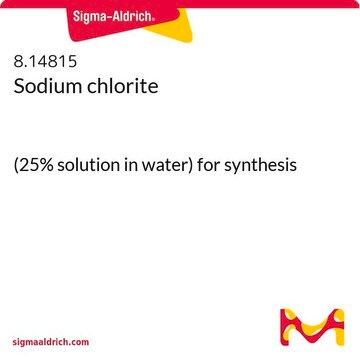All Photos(4)
About This Item
Linear Formula:
NaClO2
CAS Number:
Molecular Weight:
90.44
MDL number:
UNSPSC Code:
12352302
PubChem Substance ID:
NACRES:
NA.55
assay:
80%
grade:
technical grade
form:
flakes
powder or crystals
powder or crystals
Recommended Products
grade
technical grade
Quality Level
assay
80%
form
flakes
powder or crystals
pH
10-11 (20 °C, 100 g/L)
SMILES string
[Na+].[O-]Cl=O
InChI
1S/ClHO2.Na/c2-1-3;/h(H,2,3);/q;+1/p-1
InChI key
UKLNMMHNWFDKNT-UHFFFAOYSA-M
Looking for similar products? Visit Product Comparison Guide
Related Categories
General description
The acidified solution of sodium chlorite has been tested for the antimicrobial action on the broiler carcasses. It was found to be effective in the reduction of natural bioburden in a prechill procedure..
Application
Sodium chlorite may be used in the synthesis of chlorine dioxide and as a hydroxylating agent for the hydroxylation of androstenedione (steroid).
Disclaimer
The product is not intended for use as a biocide under global biocide regulations, including but not limited to US EPA′s Federal Insecticide Fungicide and Rodenticide Act, European Biocidal Products Regulation, Canada’s Pest Management Regulatory Agency, Turkey’s Biocidal Products Regulation, Korea’s Consumer Chemical Products and Biocide Safety Management Act (K-BPR) and others.
signalword
Danger
Hazard Classifications
Acute Tox. 2 Dermal - Acute Tox. 4 Oral - Aquatic Acute 1 - Aquatic Chronic 1 - Eye Dam. 1 - Ox. Sol. 1 - Skin Corr. 1B - STOT RE 2
target_organs
spleen
supp_hazards
Storage Class
5.1A - Strongly oxidizing hazardous materials
wgk_germany
WGK 2
flash_point_f
Not applicable
flash_point_c
Not applicable
Choose from one of the most recent versions:
Already Own This Product?
Find documentation for the products that you have recently purchased in the Document Library.
Customers Also Viewed
Sodium periodate, sodium chlorite, organic hydroperoxides, and H2O2 as hydroxylating agents in steroid hydroxylation reactions catalyzed by partially purified cytochrome P-450.
Hrycay EG, et al.
Biochemical and Biophysical Research Communications, 66(1), 209- 216 (1975)
G K Kemp et al.
Journal of food protection, 63(8), 1087-1092 (2000-08-17)
An acidified sodium chlorite (ASC) solution was investigated for its antimicrobial effects on broiler carcasses processed under conditions similar to those used in U.S. commercial poultry facilities. Of particular interest was the ability of the ASC solution to reduce natural
C L Franklin et al.
Journal of the American Veterinary Medical Association, 198(9), 1625-1630 (1991-05-01)
Copper sulfate and a metastabilized chlorous acid/chlorine dioxide (MECA) compound were evaluated for efficacy in treating Trichophyton mentagrophytes infection in rabbits. Forty rabbits naturally infected with T mentagrophytes were allotted to 5 treatment groups: nontreated control, sham dip, 1% copper
S P Oliver et al.
Journal of dairy science, 76(1), 287-292 (1993-01-01)
The objective of this study was to evaluate the efficacy of a premilking teat disinfectant for the prevention of mastitis in dairy cows under natural exposure conditions. Predipping was compared with a negative control using a split udder experimental design.
Sun-Young Lee et al.
Journal of food protection, 65(7), 1088-1092 (2002-07-16)
This study was undertaken to compare the efficacies of chlorous acid (268 ppm), sodium hypochlorite (200 ppm), and lactic acid (2%) in eliminating total mesophilic microorganisms, Salmonella Typhimurium, and Listeria monocytogenes on commercial mung bean sprouts immediately after treatment and
Our team of scientists has experience in all areas of research including Life Science, Material Science, Chemical Synthesis, Chromatography, Analytical and many others.
Contact Technical Service

















